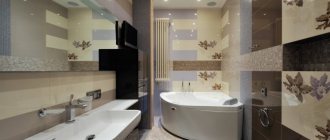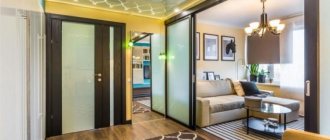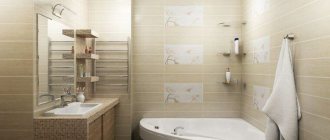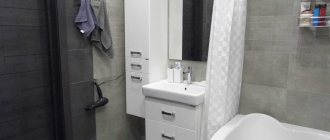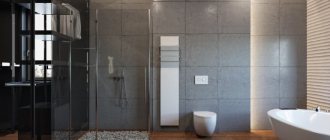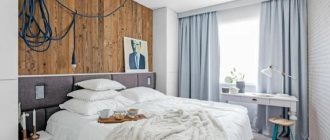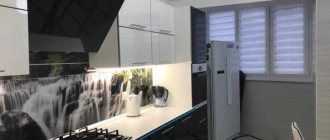Nuances and rules for finishing a suspended ceiling in the bathroom
A suspended ceiling in a home bathroom is a multifunctional system that is not afraid of humidity, dust, dirt, and mold. It will not begin to crumble after years, has a high degree of strength, and looks attractive in both miniature and spacious rooms.
Thus, the optimal materials for bathroom fabric are:
- resistant to water splashes and steam;
- strong and durable;
- easy to clean and wash;
- have antistatic properties;
- beautiful.
Below we tell you how to choose the right canvas for your bathroom.
Frame for the structure
For this device, a frame is made that can stretch the PVC film at a short distance from the base ceiling.
During operation, the film is heated and stretched, and is also made elastic, like the surface of a drum. Behind it you can hide all the bumps, pipes and other unsightly elements.
Types of suspended ceilings
There are several types of suspended ceilings, since the base for them is a canvas stretched over a frame. And not every material reacts well to a humid environment.
Therefore, before installation work, it is important to understand the types of surfaces. They are divided into two subgroups:
- Made from PVC film (polyvinyl chloride).
- Made from fabric base.
Stretch ceilings differ in their user characteristics. We strongly recommend using the first option for bathrooms, since only a PVC film sheet can optimally withstand a room with a high humidity level.
However, fabric ceilings can also be found in the bathroom if it has a fairly large area and is well ventilated naturally. Let's look at them in a little more detail.
PVC stretch ceilings
Unpretentious and moisture-resistant vinyl sheets are an ideal option for finishing a bathroom. In total, there are 3 types of PVC film, therefore the following types of ceilings differ:
- Glossy: has a good ability to reflect, sometimes it becomes completely mirror-like. This creative method allows you not only to turn the room into a stylish space, but also to visually “double” the bathroom. The result is the effect of a spacious and light-filled bathroom. The canvas perfectly complements high-tech and modern interiors.
- Matte: this stretch ceiling feels like fabric and does not reflect light rays. The design fits perfectly into a space with a significant number of shiny surfaces. This option looks good in minimalist and classic interiors, loft, country and Provence.
- Satin: Has a soft and slightly dull shine. The material is universal for a bathroom of absolutely any color, type, style, height and area.
Advantages:
- elastic, holds water well, suitable for subsequent use even after flooding;
- resistant to any type of dirt;
- has three types of texture, varied design: a significant selection of colors and shades, photo printing is available, as well as a 3D effect;
- safe for human health.
Flaws:
- has a limited film width (up to 3 meters), which is why in rooms with a large area it may require connecting several elements with a visible seam even with the most careful soldering;
- easily damaged by sharp objects;
- difficult to install, work is performed only by professionals using a heat gun;
- susceptible to low temperatures, therefore not recommended for use in country houses where there is no heating in winter;
- can provoke mold growth under the ceiling;
- high price.
Cost: from 200 to 6500 rubles per m2.
Price range of different types of PVC ceilings
Fabric stretch ceiling
The composition is created from polyester, after which the fabric is impregnated with certain solutions. Such ceilings are endowed with high reliability, monumentality, and are resistant to mechanical and other external influences.
Installation in bathrooms is carried out using a seamless method, but in rare cases there are prefabricated options.
Visual difference between a PVC ceiling and a fabric ceiling.
The solution is suitable for classic interiors. It creates a surface that is devoid of shine and has a texture that is pleasant to the touch.
From the outside, the finished ceiling will differ little from simple plaster. It can be painted, hand-painted or photographically printed.
Advantages:
- has a large width, making it possible to cover the bathroom with just one sheet;
- air and vapor permeable, so mold and other microorganisms do not form between the coating and the ceiling;
- easy to install, no auxiliary equipment or specialist assistance required;
- durable, resistant to environmental influences;
- immune to temperature changes;
- environmentally friendly;
- looks good in the interior of the bathroom at home.
Flaws:
- high price;
- short service life;
- does not protect against flooding, becomes deformed and becomes unusable;
- It is difficult to wash off splashes and limescale deposits;
- has an exclusively matte surface.
Cost: from 520 to 5000 rubles per m2.
Advantages and disadvantages of tensile structures
Advantages:
- Its appearance is excellent;
- Practicality and reliability of the design;
- Does not require preparatory actions in relation to the main ceiling;
- Does not require further finishing;
- Holds water during flooding;
- Durable;
- The structure will not crack;
- Quick installation, with experienced technicians;
- Low cost;
- Wide choice of colors.
Flaws:
- Does not withstand mechanical damage;
- Repair is not possible;
- Impossibility of installation without the experience of craftsmen and special tools.
Correct lighting
Whatever tension structure you choose, it is important to provide it with high-quality lighting in advance. The exact number of ceiling lights and their variety should be planned before installation work with the canvas. After all, the brightness of the colors of the space and the appearance of the bathroom decoration often depend on them.
Classic bathroom fixtures come in built-in and surface-mounted types. For them, before starting installation work, holes are prepared in the ceiling, plastic rings are glued and spotlights are laid. Let's study the pros and main disadvantages of each type:
| Built-in | Invoices | |
| pros | They have low thermal conductivity. They are economical. They work without interruption. They have an increased level of energy saving. They are durable (service life - up to ten years). | They are attached above the ceiling, so all types of lamps can be used here. They have the ability to change the angle of inclination. |
| Minuses | Bluish and cold glow (not for every room). | The need for careful selection of design (otherwise the interior style will be disrupted). |
Attention! If desired, lighting in the home bathroom can be organized using chandeliers, spotlights or raster lamps.
A few additional tips:
- The illumination of the bathroom should be from 200 lux.
- PVC fabric tends to melt at elevated temperatures, so lamps with a power exceeding 40 W should not be installed in it.
- The bathroom in an apartment is a high-risk area, because... it is prone to flooding and has high humidity, which has a bad effect on electrical appliances. In this regard, it is recommended to select lamps that are marked IP 7-8 units (which means the maximum level of water resistance).
- If you fill the space with several lighting fixtures at once, the room will turn out to be cozy, better filled with light and begin to seem more voluminous.
Requirements
The microclimate in the bathroom is unstable due to hot steam and condensation. Because of this, problems may arise when finishing the bathroom.
Therefore, the ceiling covering has some requirements and features:
- Moisture resistance;
- Resistance to temperature changes;
- Durability, durability and strength;
- Antistatic properties;
- Easy to clean.
In the modern world, it is no longer difficult to find stretch ceilings that meet these requirements.
Choosing a reliable stretch ceiling
Not every homeowner knows how to choose the right suspended ceiling, because there are a number of nuances. If you are planning to install suspended ceilings in the bathroom and toilet, then when choosing a reliable fabric, we recommend taking into account the following indicators:
- room dimensions;
- shades and texture of room decoration, plumbing fixtures and furniture;
- planned or existing lighting in the bathroom;
- the presence of utilities in the room that will need to be hidden.
Tips for choosing a stretch ceiling and its cost
The choice of fabric often depends on the size and location of the bathroom:
| Peculiarities | Materials | Color |
| No constant heating in the room (dacha, country house) | Fabric that can be used at temperatures down to -40 degrees | Any |
| Spacious bathroom in a simple apartment with an ordinary ceiling height | PVC | Any solid color or with a print, effects are possible |
| Large room area, higher than average ceiling height | PVC, incl. multi-level | Any combination of colors with prints and effects |
| Miniature area, above average height | Satin or matte PVC, two-tier design | Light and cool tone |
| Small area, normal height | Satin or glossy PVC | Light and cool tone |
Suspended plasterboard ceiling
The most popular type of suspended ceilings is still plasterboard ceilings. Their features include:
- Affordable material cost
- Ability to create designs of different shapes and sizes
- Treatment with a moisture-protective compound to extend service life
- Perfectly flat surface
- Environmental friendliness and maintaining a normal microclimate
- Easy installation and variety of appearance
Work on installing a plasterboard ceiling includes installation, putty, primer and painting. Heavy structures cannot be attached to drywall; this is the only nuance that is worth considering.

